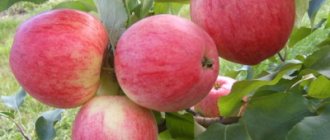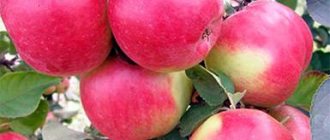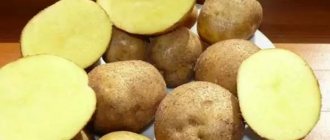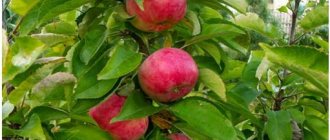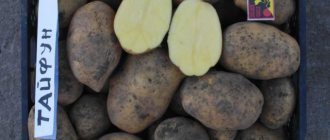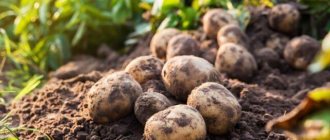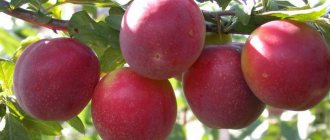The apple tree “Streifling” (“Strifel”) is of Baltic origin, but most domestic summer residents are very familiar with it under the name “Autumn Striped”. This ancient variety of folk selection originally appeared presumably in Holland back in the 18th century, but to this day remains one of the most beloved and widespread in central Russia, Belarus and, naturally, in the Baltic countries.
"Streifling" (pictured) is rightfully considered the standard of autumn apples
If you are interested in what the features of the variety are, we suggest starting by considering its main characteristics in the table:
| Parameter | Characteristic |
| Culture | Apple tree (Malus domestica Borkh.) |
| Variety | “Autumn Striped” (Shtreifling, Striefel), popular names: Autumn Striped, Strifel, Livlyandskoe, Amtmanskoe, Obrezkovoe, Starostino |
| Tree height | Tall – up to 8-10 m |
| Precociousness | Relatively low - in the 8-9th year after planting |
| Terms of removable (technical) maturity | Third ten days of August – early September |
| Period of consumption/shelf life of fruits | Autumn (late autumn) – apples are stored until December |
| Type of fruiting | Mixed - on ringlets and fruit twigs |
| Productivity per tree | Very high – more than 200 kg |
| Fruit weight | On average 80-100 g (under favorable conditions 140-150 g) |
| Shape and color | The fruits are truncated or round-conical in shape, often unequal, with pronounced ribs at the base. The skin is thin, smooth, covered with a waxy coating. The main color is greenish-yellow (when picked) and yellow (when reaching full maturity). The integumentary layer - in the form of bright orange-red stripes on a speckled background, is present on most of the surface of the fruit, and becomes brownish when ripe. Red fruit mutations have apples that are a solid dark red color. |
| Fruit pulp | Light, yellowish, sometimes with a pink tint under the skin, loose, quite juicy |
| Tasting assessment (taste qualities) | 4.5 points (out of 5) – sweet and sour taste, harmonious |
| Purpose of fruits | Dessert (universal - suitable for various processing methods) |
| Sustainability | Frost-resistant, weakly resistant to drought, moderately affected by fruit and leaf scab |
| Year of inclusion in the State Register of the Russian Federation | 1947 |
| Recommended growing regions | Northern, Northwestern, Central, Volga-Vyatka, Central Black Earth, Middle Volga |
| Originators | OJSC Agro-Industrial Society "Taitsy" (Leningrad region), Federal State Budgetary Institution "Federal Agrarian Scientific Center of the North-East named after N.V. Rudnitsky" (Kirov) |
Description and characteristics of the variety
The origin of the Striefel apple tree is hidden in the depths of centuries. The name suggests that it comes from Holland, Germany or the Netherlands. The apples were a success; their taste delighted the people of Europe. They came to our country from the Baltic states, which is why Striefel is sometimes called the Baltic apple. In Russia, the variety was officially registered and received recognition after the Second World War, in 1947 under the name “Autumn Striped”. According to the description in the State Register, the Striefel variety was intended for cultivation in the European part of our country.
Height
Compared to other varieties, Striefel is striking in its power and size. The botanical description says that a mature tree reaches a height of 7-8 meters. Growth shoots ensure rapid growth, and a long life expectancy guarantees long-term yields of striped apples.
Crown width
The apple tree of the Striefel variety forms a regular-shaped crown, which, according to the description, resembles an overturned cauldron. This configuration is associated with the growth of skeletal branches that extend from the trunk at right angles and hang down at the edge. Growth shoots and fruit twigs, thanks to abundant branching, thicken the crown. Its width reaches 8-9 m, so the Striefel apple tree creates shade for nearby trees or shrubs.
Apples are formed on 3-4 year old ringlets, as well as on last year's branches. The variety belongs to those apple trees that are distinguished by a mixed type of fruiting. This factor matters when pruning.
Tasting assessment
The Striefel variety is difficult to confuse with another variety: there are no similar options. It is recognizable as White filling or Antonovka, reminiscent of the taste of childhood: sweet with slight sourness, a delicate aftertaste and light clove notes. The description of the varietal characteristics says that the tasting score is 4.5 points out of 5 possible.
There may be some discrepancies in describing the taste of apples. This is due to Striefel’s ability to cross-pollinate with other varieties, which creates an abundance of “clones” that differ from the classic version of the fruit both in appearance and taste.
Winter hardiness and drought resistance
The Striefel variety is a strong variety; it can withstand the frosts of the middle zone quite well. Frost resistance is rated above average. The tree of the Striefel variety freezes at t=-40°C and recovers after 2 years. Shelter is created for young plants; “wrapping” an 8-meter tree is quite problematic. In cold climates, gardeners practice growing slate, creeping forms of apple trees.
According to the description of experienced gardeners, drought resistance is low. The Striefel variety is characterized by good growth only with abundant watering. With proper irrigation, the apple tree will produce ripe, striped fruits. In dry years with minimal moisture, there is no expectation of an apple harvest.
Advantages and disadvantages
Striefel is an autumn variety: apples ripen during September. The specific harvest time depends on the growing region. When describing a variety, one cannot ignore its main characteristics, pros and cons. The positive and most valuable qualities of an apple tree include:
- stable, annual fruiting: up to 100-300 kg of apples from a mature tree;
- bright taste and delicate aroma of fruits;
- universal use: apples are tasty fresh and suitable for various preparations;
- resistance to cold and return frosts;
- climatic plasticity: the ability to grow and bear fruit in different temperature ranges;
- average disease resistance.
The Striefel variety has some disadvantages:
- powerful dimensions that complicate maintenance;
- apples do not ripen quickly, full fruiting begins at the age of 15-18 years;
- the first fruiting occurs at 7-8 years;
- low resistance to drought: in the absence of irrigation, there is no need to wait for the harvest;
- the Striefel tree is self-sterile; it bears fruit if there are 3 pollinating varieties on the site: Antonovka, Anis, and Belyi naliv are suitable for these purposes; Slavyanka, Welsey, Kutuzovets, Papirovka;
- insufficient resistance to scab, which appears on the tree in cool, rainy summers;
- short-term storage of apples;
- Old or unkempt apple trees are characterized by periodic fruiting.
It is important to harvest on time, although the fruits stick well to the branches and do not fall off. Ripe apples, being on the tree for a long time, lose their juiciness and freshness. The pulp becomes less dense. The same thing happens during storage, when fruits lose their appearance and transportability.
Productivity
Yields may vary by region. For example, in central Russia you need to use a complex of fertilizers to obtain a sufficient number of apples. In different regions, the yield from one plant can range from 80 to 150 kilograms. Apple trees that are over 15 years old have the best performance.
In the central zone of our country, a crop that has been growing for more than 25 years can produce up to 300 kilograms of apples. The harvest begins in early or mid-September, depending on the current weather.
Landing Features
The description of the planting scheme for any apple tree seedling is traditional, but it is important to take into account the varietal characteristics of the Striefel variety. A tree grows in one place for a long time, so it is so important to avoid mistakes when planting a plant and find the right place for planting.
Dates and place
The Striefel apple variety is best planted in the middle zone in the spring. Over the summer, the seedling will get stronger, develop a root system and survive the first winter well. When choosing the right location, a number of factors should be taken into account:
- tree dimensions: a tall apple tree will require an area 1.5 times larger than the trunk circle;
- sunny and open area;
- elevation so that there is no groundwater nearby.
The Striefel apple tree will not bear fruit in the shade or in swampy areas. In places where cold air stagnates or winds rage.
The Autumn Striped apple variety also takes root well during autumn planting, which should be done a month before the first frost. One-year-old seedlings have better survival rate, and two-year-old seedlings enter the fruiting period earlier.
Preparing for landing
Seedlings of the Striefel variety are purchased from garden nurseries or from experienced gardeners. Check the condition of the fruit crop, which should fit the following description:
- have a branched root system with 3 main roots;
- the roots should be moist and light when cut;
- the grafting site is covered with bark;
- the trunk under the bark is soft green in color;
- 1-2 shoots on the main trunk.
The right purchase is a seedling with a closed root system and a small number of leaves. The leaves absorb the bulk of the nutrients, so it is difficult for a young, 1-2 year old plant to take root.
The open root system should be wrapped in a wet cloth to prevent it from drying out or kept in a clay mash to minimize the evaporation of moisture from the surface. Before planting, the seedlings are left in a cool room. If the roots have dried out, then on the eve of planting they need to be kept in warm water for 48 hours. The right move is to add Kornevin or another growth stimulant.
Planting a seedling
The planting hole for the Striefel apple tree is prepared in advance, keeping the dimensions 1.2 cm in diameter and 0.8 cm in depth. The top layer of the most fertile soil is removed, which is mixed with fertilizers: 25-30 liters of rotted manure, 250 g of simple superphosphate, 60 g of potassium sulfate. If the soil is acidic, then add 250-400 g of crushed chalk or dolomite flour to the resulting mixture. You can limit yourself to humus and crushed chalk, to which 2 liters of ash are added.
Knowing how to plant a tree correctly, you can count on subsequent apple harvests. Spring or autumn planting is carried out according to the traditional scheme:
- Drainage is placed at the bottom of the planting hole (on heavy loams), fertile soil mixed with fertilizers is poured in the form of a mound.
- They visit the seedling on the hill, spreading the root system over its surface.
- Cover with soil, leaving the root collar on the surface (10 cm above the ground).
- The earth in the tree trunk circle is compacted so that there are no voids. Water generously.
- The tree trunk circle is mulched with sawdust or peat in a layer of 15-18 cm.
- The seedling is tied to a stake, providing stability when the ground settles.
The correct option is fertile, light soil with neutral acidity. It is worth taking into account all the nuances of the soil in a particular area, since ideal soil is extremely rare. Reasonably applied fertilizers will provide nutrition to the tree for 2-3 years.
Rootstock options
On the dwarf
If you graft the Autumn Striped variety onto a dwarf rootstock, it will acquire some new qualities.
The height of the tree will rarely exceed 3 m, even without special pruning. Only the side branches will need to be trimmed. The first harvest has been harvested for more than 4-5 years.
Winter hardiness in this case is lower, although some gardeners claim that this is not so.
On the columnar
The tree has a narrow crown, in which the branches are directed upward, parallel to the trunk, side shoots are not formed. The height reaches no more than 1.5-2 m. The branches begin to grow already at 30 cm above the ground. The apples evenly cover the entire stem.
It begins to bear fruit early. Already in the 7-8th year, up to 18-20 kg of crop is harvested. The species will be winter-hardy and is rarely damaged by insects and fungi.
Rules of care
Proper care of the Striefel apple tree involves taking into account the characteristics that this variety has. When describing care, you should pay attention to the main measures to get an excellent harvest of apples.
Watering
The Striefel variety is moisture-loving, therefore it needs watering during the growth of shoots and the formation of ovaries, 2 weeks before the start of fruit harvesting (watering on the eve of fruiting is undesirable), in October, when the crop is harvested, in preparation for the winter period. The tree is responsive to sprinkling on hot days and warm autumn
Correct, reasonable amounts of moisture depend on the age of the apple tree:
- a 2nd year seedling needs 40 liters of water;
- an older plant consumes up to 80 liters;
- after 20 years, the apple tree requires 120 liters.
The moisture should wet the soil to a depth of up to a meter. After shedding the soil, the tree trunk circle is carefully mulched to retain water in the ground.
Top dressing
At the beginning of growth, the Striefel apple seedling grows due to the nutrients added to the planting hole. 2 years after planting, urea is added to stimulate growth in the spring. Use root watering or foliar feeding on the leaf.
The description says that during the period when the Striefel apple tree is growing, fertilizers are applied three times per season:
- in May urea is added;
- in June, nitrophoska is introduced;
- in August they are fed with superphosphate and potassium salt.
The drugs are diluted as described in the instructions. After watering with a fertilizer solution, water with clean water so that the nutrients are more evenly distributed in the soil and reach the root system. At the same time, organic matter is added: mullein solution or chicken manure. The right approach is a combination of organic and mineral nutrition.
Proceed strictly according to the instructions. Do not overload the soil with nutrients. Do not apply nitrogen compounds in the fall that stimulate growth as the tree prepares for dormancy. The correct, ecological approach will help preserve the soil and the taste of the fruit.
Crown formation rules
When describing the crown of the Striefel apple tree, it was said that it resembles an inverted bowl. Its correct formation begins 2-3 years after planting. This procedure is then carried out annually. The formation occurs in tiers - leaving 2-3 skeletal branches in each. The correct location is 20 cm between branches and 80 cm between tiers. The central conductor is shortened by 40 cm.
Trimming
For the Striefel variety, gentle pruning is practiced. With the right approach, the branches are balanced by shortening them by 1⁄4 in relation to the central conductor. The main task of the gardener is to maintain proper growth and get rid of excess fruit-bearing branches. In the spring, before sap flow begins, dry branches located inside the crown or at an acute angle to the trunk are removed.
The crown is formed in stages, cutting off branches from the southern side one year, and moving to the northern side the next year. The tree loses its attractiveness, but with proper pruning it recovers quite quickly.
Preparing for winter
The correct approach to preparing the Striefel variety for winter includes the following points:
- pruning;
- abundant watering;
- fertilizing with phosphorus-potassium compounds;
- mulching.
The Striefel apple tree can withstand frost well, but young plants need shelter. Peat, spruce branches, and covering material are used. When the snow melts in the spring, the cover must be removed to avoid damping off the plant.
Harvest and storage
In the description of the variety it was said about the regular yield of fruits. The Striefel variety produces an annual apple harvest for up to 30 years. Then fruiting becomes periodic: the apple harvest does not occur every year. The maximum yield during the growing season of the Striefel tree is 300 kg of apples, but it all depends on the growing zone and proper care.
Harvest occurs in September. Apples are removed from the tree at the technical maturity stage. Their shelf life and transportability are low, but with the right approach, striped apples can be stored for up to 3 months. How to preserve fruits? They are laid out in wooden, ventilated (with holes) boxes, lined with sawdust or paper. They check periodically, removing rotten specimens.
The bulk of apples of the Striefel variety are used for processing. The excellent taste allows you to prepare a variety of desserts from the fruit.
Reviews
Nikita, 29 years old, Nizhny Novgorod: “Probably everyone is familiar with this variety. Our neighbors had a large apple tree in their dacha, we also planted one for ourselves. There are a lot of apples, we make jam, juice and compote from them. We quickly fill up with fresh ones, it’s a pity that they don’t last long.”
Veronica, 41 years old, Yekaterinburg: “I really love these ruddy apples, they are sweet and sour and very juicy. True, the apple tree is simply huge; it’s not always possible to pick apples even from the very top.”
Features of cultivation in different regions of Russia
| Region | Features of cultivation |
| Moscow region | On loams and soddy-podzolic soils, the apple tree needs rare watering. Mild winters protect against freezing. The mild climate ensures a good harvest of apples. |
| Volga region | Light soil requires abundant watering. a warm and mild climate with proper agricultural technology promotes annual fruiting. Apples are often affected by the codling moth. |
| Leningrad region | In mild and rainy climates, the variety is often affected by scab. With the right approach, preventive measures are taken against a disease that can destroy the entire apple crop. |
Pollinator trees
For good fruit set, the Streifling apple tree needs to be placed near the following pollinating trees:
- Padding;
- Welsey;
- Antonovka;
- Cinnamon striped.
Padding
Antonovka
Welsey
Cinnamon striped
Other similar varieties are also suitable. The number of pollinators should be at least a third of Streifling's.
Diseases and pests
The Striefel apple variety is affected by a number of bacterial infections. It is susceptible to powdery mildew, suffers from fruit rot, and is not resistant to scab. Rarely suffers from bacterial cancer. The correct approach is to carry out preventive treatment twice to prevent diseases: before the buds open and with the appearance of the first foliage. They use copper-containing drugs and Inta-vir.
A variety of pests settle on the apple tree, against which active control is being carried out: apple moth, sawfly, aphids, scale insects, bark beetles, mites. The strifel should be periodically inspected for the presence of pests and the tree should be provided with “first aid measures” using folk remedies. In case of mass destruction, “chemistry” is used.
The Striefel variety has stood the test of time with dignity. Over the two centuries of their existence, apples have been loved by residents of the entire continent. It was and remains one of the most famous and sought after varieties, and still reminds many people of childhood.


